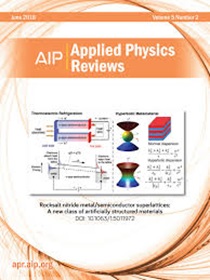Acoustics in additive manufacturing: A path toward contactless, scalable, and high-precision manufacturing
IF 11.6
1区 物理与天体物理
Q1 PHYSICS, APPLIED
引用次数: 0
Abstract
Acoustic techniques have emerged as a transformative approach in additive manufacturing, enabling contactless, high-precision manipulation of particles, droplets, and cells through acoustic wavefields. While acoustic patterning has demonstrated remarkable control over microscale spatial configurations, its scalability into three-dimensional (3D) fabrication has remained constrained by challenges in bonding limitations and vertical stacking. To solve this challenge, hybrid acoustic-assisted 3D printing integrates acoustophoresis with established methods, such as direct ink writing and stereolithography, enhancing material deposition accuracy, microstructure alignment, and porous structuring of 3D printed products. However, these hybrid systems remain tethered to layer-by-layer architectures, limiting the full potential of acoustic techniques. Recent breakthroughs in standalone acoustic 3D fabrication, leveraging levitation, focusing, and ejection, have unlocked potential in contactless, layerless, and flexible multi-material assembly. Acoustic levitation systems enable mid-air construction on non-planar surfaces, and focused ultrasound techniques facilitate deep-penetration polymerization and acoustic droplet ejection advances nozzle-free droplet-based bioprinting. This review systematically evaluates the evolution of acoustics in additive manufacturing, addressing critical challenges in material compatibility, resolution, and scalability, while outlining the future of acoustics in additive manufacturing technology.增材制造中的声学:通往非接触、可扩展和高精度制造的道路
声学技术已经成为增材制造的一种变革性方法,可以通过声波场对颗粒、液滴和细胞进行非接触、高精度的操作。虽然声学模式已经证明了对微尺度空间结构的显著控制,但其在三维(3D)制造中的可扩展性仍然受到键合限制和垂直堆叠的挑战的限制。为了解决这一挑战,混合声辅助3D打印将声阻抗与现有方法(如直接墨水书写和立体光刻)相结合,提高了3D打印产品的材料沉积精度、微观结构对齐和多孔结构。然而,这些混合系统仍然局限于逐层架构,限制了声学技术的全部潜力。最近在独立声学3D制造方面的突破,利用悬浮、聚焦和弹射,释放了非接触、无层和柔性多材料组装的潜力。声学悬浮系统可以在非平面表面上进行半空中构造,聚焦超声技术可以促进深度渗透聚合,声学液滴喷射可以推进无喷嘴液滴生物打印。本文系统地评估了增材制造声学的发展,解决了材料兼容性、分辨率和可扩展性方面的关键挑战,同时概述了增材制造技术声学的未来。
本文章由计算机程序翻译,如有差异,请以英文原文为准。
求助全文
约1分钟内获得全文
求助全文
来源期刊

Applied physics reviews
PHYSICS, APPLIED-
CiteScore
22.50
自引率
2.00%
发文量
113
审稿时长
2 months
期刊介绍:
Applied Physics Reviews (APR) is a journal featuring articles on critical topics in experimental or theoretical research in applied physics and applications of physics to other scientific and engineering branches. The publication includes two main types of articles:
Original Research: These articles report on high-quality, novel research studies that are of significant interest to the applied physics community.
Reviews: Review articles in APR can either be authoritative and comprehensive assessments of established areas of applied physics or short, timely reviews of recent advances in established fields or emerging areas of applied physics.
 求助内容:
求助内容: 应助结果提醒方式:
应助结果提醒方式:


